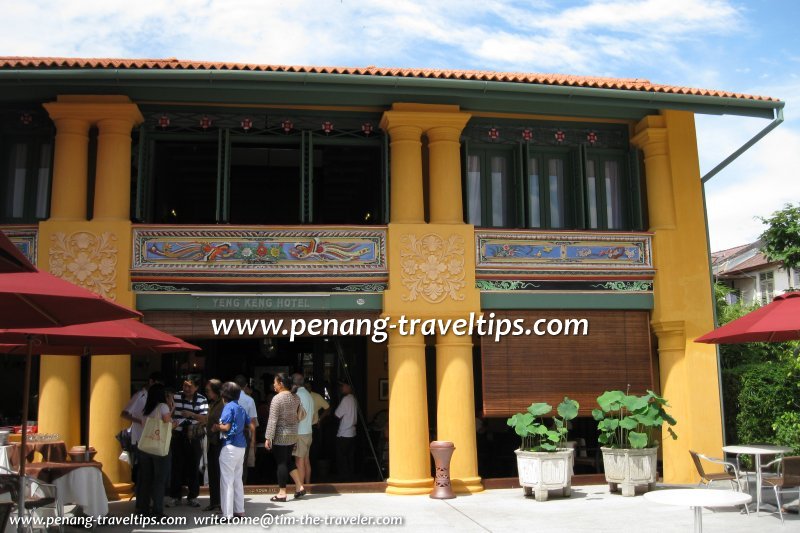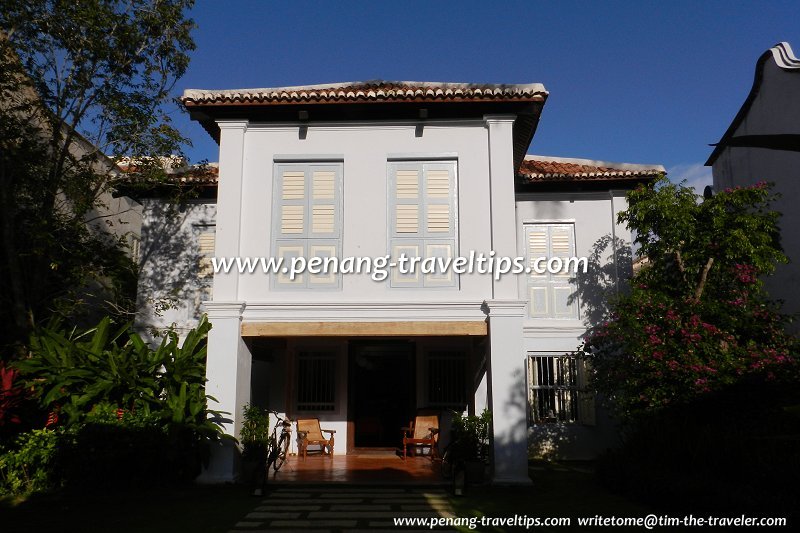Anglo-Indian Bungalows were prevalent in George Town from the late 18th to the third quarter of the 19th century. This coincides with a period when the South Indian community had a dominant presence in the settlement. By the second quarter of the 19th century, the dominance was gradually eroded by increasing influence of the ethnic Chinese communities.
 Yeng Keng Hotel, an example of an Anglo-Indian bungalow on Chulia Street (16 April 2011)
Yeng Keng Hotel, an example of an Anglo-Indian bungalow on Chulia Street (16 April 2011)

By the mid 19th century, large-scale migration of Chinese from the southern provinces of Fujian and Guangdong transformed the character of George Town. The Cantonese, Hakka and Hainanese took over parts of George Town which were previously occupied by various Indian communities, so much so that areas such as Chulia Street and Kampung Malabar, originally Indian in character, remain Indian only by name today.
Some of the earliest structures along Market Street, Queen Street, Pitt Street, Chulia Street and Penang Road were Anglo Indian in architectural style. The majority were built of wood with thatch roofing. All of these have long been replaced by brick shophouses and townhouses today. There are still a sporadic remnant of Anglo Indian brick houses tucked away in various nooks of George Town today.
 23 Love Lane is another example of an Anglo-Indian bungalow, now a boutique hotel (5 August 2012)
23 Love Lane is another example of an Anglo-Indian bungalow, now a boutique hotel (5 August 2012)

The Anglo-Indian bungalow developed in India during the Georgian period. As it spread to this region, it was modified to suit the local climate, forming the basis for the Indo-Malay bungalow, which then evolves to become the Malay Straits Eclectic, as exemplified by the Teh Bunga Mansion and Syed Alatas Mansion.
The number of Anglo-Indian bungalows still standing today in George Town can well be numbered with one hand. One of the best preserved examples in Yeng Keng Hotel, a fine example of how a property that originally belonged to an Indian owner was given a Chinese name after it changed hands.
As I researched for this article, I asked conservation architect Dr Gwyn Jenkins for her opinion on the Anglo-Indian bungalows in George Town. According to her, the architectural form of the Anglo-Indian bungalow goes beyond looks or façades; it's about the plan, social and cultural use and function, orientation and material used.

 Yeng Keng Hotel, an example of an Anglo-Indian bungalow on Chulia Street (16 April 2011)
Yeng Keng Hotel, an example of an Anglo-Indian bungalow on Chulia Street (16 April 2011)
By the mid 19th century, large-scale migration of Chinese from the southern provinces of Fujian and Guangdong transformed the character of George Town. The Cantonese, Hakka and Hainanese took over parts of George Town which were previously occupied by various Indian communities, so much so that areas such as Chulia Street and Kampung Malabar, originally Indian in character, remain Indian only by name today.
Some of the earliest structures along Market Street, Queen Street, Pitt Street, Chulia Street and Penang Road were Anglo Indian in architectural style. The majority were built of wood with thatch roofing. All of these have long been replaced by brick shophouses and townhouses today. There are still a sporadic remnant of Anglo Indian brick houses tucked away in various nooks of George Town today.
 23 Love Lane is another example of an Anglo-Indian bungalow, now a boutique hotel (5 August 2012)
23 Love Lane is another example of an Anglo-Indian bungalow, now a boutique hotel (5 August 2012)
The Anglo-Indian bungalow developed in India during the Georgian period. As it spread to this region, it was modified to suit the local climate, forming the basis for the Indo-Malay bungalow, which then evolves to become the Malay Straits Eclectic, as exemplified by the Teh Bunga Mansion and Syed Alatas Mansion.
The number of Anglo-Indian bungalows still standing today in George Town can well be numbered with one hand. One of the best preserved examples in Yeng Keng Hotel, a fine example of how a property that originally belonged to an Indian owner was given a Chinese name after it changed hands.
As I researched for this article, I asked conservation architect Dr Gwyn Jenkins for her opinion on the Anglo-Indian bungalows in George Town. According to her, the architectural form of the Anglo-Indian bungalow goes beyond looks or façades; it's about the plan, social and cultural use and function, orientation and material used.
Examples of Anglo-Indian Buildings in George Town
Further Reading
Even today, there is a sprinkling of village houses within the modern city of George Town. In the article, Village Houses in George Town, we explore the city and identify the village houses that are now within an urban setting.Architectural Styles of Buildings in George Town

Copyright © 2003-2025 Timothy Tye. All Rights Reserved.

 Go Back
Go Back